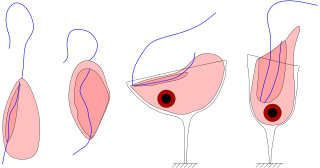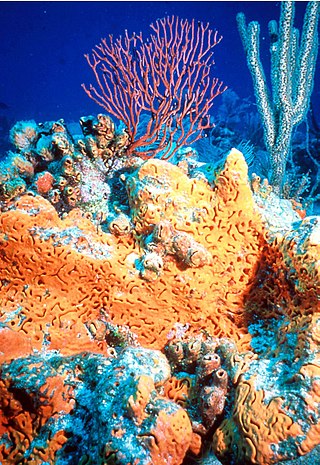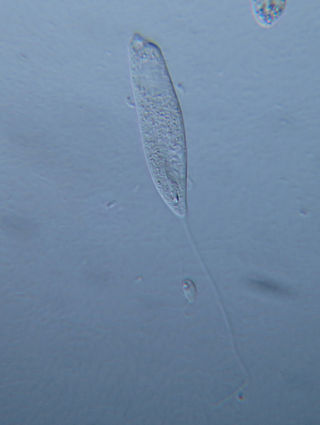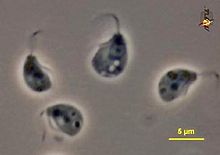
Excavata is an extensive and diverse but paraphyletic group of unicellular Eukaryota. The group was first suggested by Simpson and Patterson in 1999 and the name latinized and assigned a rank by Thomas Cavalier-Smith in 2002. It contains a variety of free-living and symbiotic protists, and includes some important parasites of humans such as Giardia and Trichomonas. Excavates were formerly considered to be included in the now obsolete Protista kingdom. They were distinguished from other lineages based on electron-microscopic information about how the cells are arranged. They are considered to be a basal flagellate lineage.

Amorphea is a taxonomic supergroup that includes the basal Amoebozoa and Obazoa. That latter contains the Opisthokonta, which includes the Fungi, Animals and the Choanomonada, or Choanoflagellates. The taxonomic affinities of the members of this clade were originally described and proposed by Thomas Cavalier-Smith in 2002.

The Apusozoa are a paraphyletic phylum of flagellate eukaryotes. They are usually around 5–20 μm in size, and occur in soils and aquatic habitats, where they feed on bacteria. They are grouped together based on the presence of an organic shell or theca under the dorsal surface of the cell.

Telonemia is a phylum of microscopic eukaryotes commonly known as telonemids. They are unicellular free-living flagellates with a unique combination of cell structures, including a highly complex cytoskeleton unseen in other eukaryotes.

Loukozoa is a proposed taxon used in some classifications of eukaryotes, consisting of the Metamonada and Malawimonadea. Ancyromonads are closely related to this group, as sister of the entire group, or as sister of the Metamonada. Amorphea may have emerged in this grouping, specifically as sister of the Malawimonads.

Malawimonas is genus of unicellular, heterotrophic flagellates with uncertain phylogenetic affinities. They have variably being assigned to Excavata and Loukozoa. Recent studies suggest they may be closely related to the Podiata.

Jakobids are an order of free-living, heterotrophic, flagellar eukaryotes in the supergroup Excavata. They are small, and can be found in aerobic and anaerobic environments. The order Jakobida, believed to be monophyletic, consists of only twenty species at present, and was classified as a group in 1993. There is ongoing research into the mitochondrial genomes of jakobids, which are unusually large and bacteria-like, evidence that jakobids may be important to the evolutionary history of eukaryotes.

Holozoa is a clade of organisms that includes animals and their closest single-celled relatives, but excludes fungi and all other organisms. Together they amount to more than 1.5 million species of purely heterotrophic organisms, including around 300 unicellular species. It consists of various subgroups, namely Metazoa and the protists Choanoflagellata, Filasterea, Pluriformea and Ichthyosporea. Along with fungi and some other groups, Holozoa is part of the Opisthokonta, a supergroup of eukaryotes. Choanofila was previously used as the name for a group similar in composition to Holozoa, but its usage is discouraged now because it excludes animals and is therefore paraphyletic.

Ancyromonadida or Planomonadida is a small group of biflagellated protists found in the soil and in aquatic habitats, where they feed on bacteria. Includes freshwater or marine organisms, benthic, dorsoventrally compressed and with two unequal flagellae, each emerging from a separate pocket. The apical anterior flagellum can be very thin or end in the cell membrane, while the posterior flagellum is long and is inserted ventrally or laterally. The cell membrane is supported by a thin single-layered theca and the mitochondrial crests are discoidal/flat.

The eukaryotes constitute the domain of Eukarya or Eukaryota, organisms whose cells have a membrane-bound nucleus. All animals, plants, fungi, and many unicellular organisms are eukaryotes. They constitute a major group of life forms alongside the two groups of prokaryotes: the Bacteria and the Archaea. Eukaryotes represent a small minority of the number of organisms, but given their generally much larger size, their collective global biomass is much larger than that of prokaryotes.

Holomycota or Nucletmycea are a basal Opisthokont clade as sister of the Holozoa. It consists of the Cristidiscoidea and the kingdom Fungi. The position of nucleariids, unicellular free-living phagotrophic amoebae, as the earliest lineage of Holomycota suggests that animals and fungi independently acquired complex multicellularity from a common unicellular ancestor and that the osmotrophic lifestyle was originated later in the divergence of this eukaryotic lineage. Opisthosporidians is a recently proposed taxonomic group that includes aphelids, Microsporidia and Cryptomycota, three groups of endoparasites.

Breviatea, commonly known as breviate amoebae, are a group of free-living, amitochondriate protists with uncertain phylogenetic position. They are biflagellate, and can live in anaerobic (oxygen-free) environments. They are currently placed in the Obazoa clade. They likely do not possess vinculin proteins. Their metabolism relies on fermentative production of ATP as an adaptation to their low-oxygen environment.

Collodictyon is a genus of single-celled, omnivorous eukaryotes belonging to the collodictyonids, also known as diphylleids. Due to their mix of cellular components, Collodictyonids do not belong to any well-known kingdom-level grouping of that domain and this makes them distinctive from other families. Recent research places them in a new 'supergroup' together with rigifilids and Mantamonas, with the so-far informal name 'CRuMs'.

Collodictyonidae is a group of aquatic, unicellular eukaryotic organisms with two to four terminal flagella. They feed by phagocytosis, ingesting other unicellular organisms like algae and bacteria. The most remarkable fact of this clade is its uncertain position in the tree of life.
Rigifilida is a clade of non-ciliate phagotrophic eukaryotes. It consists of two genera: Micronuclearia and Rigifila.

Podiates are a proposed clade containing the Amorphea and the organisms now assigned to the clade CRuMs. Ancyromonadida does not appear to have emerged in this grouping. Sarcomastigota is a proposed subkingdom that includes all the podiates that are not animals or fungi. Sulcozoa is a proposed phylum within Sarcomastigota that does not include the phyla Amoebozoa (clade) and Choanozoa (paraphyletic), i.e. it includes the proposed subphyla Apusozoa and Varisulca

The Phragmoplastophyta are a proposed sister clade of the Klebsormidiaceae in the Streptophyte/Charophyte clade. The Phragmoplastophyta consist of the Charophycaea and another unnamed clade which contains the Coleochaetophyceae, Zygnematophyceae, Mesotaeniaceae, and Embryophytes. It is an important step in the emergence of land plants within the green algae. It is equivalent to the ZCC clade/grade, cladistically granting the Embryophyta.

Gefionella is a genus of excavate protists belonging to the family Malawimonadidae, a basal group in the evolution of eukaryotes. It is a monotypic genus, with only the species Gefionella okellyi, described in 2018. The genus is named after the Norse goddess Gefjon, while the species is named after the scientist Charles J. O'Kelly, a pioneer in the ultrastructural and phylogenetic investigation of excavate flagellates.

Malawimonads are a small group of microorganisms with a basal position in the evolutionary tree of eukaryotes, containing only three recognized species. They're considered part of a paraphyletic group known as "Excavata".

The peranemids are a group of phagotrophic flagellates, single-celled eukaryotes or protists, belonging to the Euglenida, a diverse lineage of flagellates that contains the closely related euglenophyte algae.

















